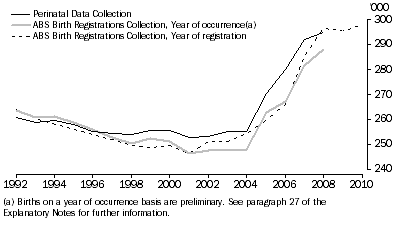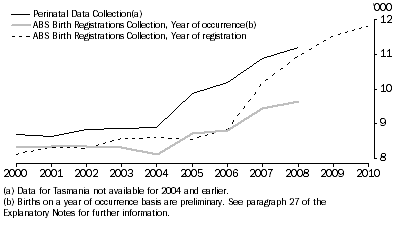APPENDIX 3 DIFFERENCES BETWEEN COLLECTIONS
BIRTH REGISTRATIONS COMPARED TO THE PERINATAL DATA COLLECTION
Birth registrations data in this publication are not the only births data available in Australia. The National Perinatal Epidemiology and Statistics Unit of the Australian Institute of Health and Welfare (AIHW) also collects birth data from midwives and other health professionals who attend births. These data are published annually in Australia's Mothers and Babies (Laws P J, Li Z, & Sullivan E A 2010, Australia's mothers and babies 2008, Perinatal statistics series no. 24. cat. no. PER 50. Canberra; AIHW).
As information from these two collections are from different sources, the statistics obtained may vary. For example, the Perinatal Data Collection reported the occurrence of 294,700 live births in Australia in 2008 (the latest available data), 0.6% fewer than the 296,600 births registered in the same year.
Graph A2.1 shows the total number of live births in Australia by type of collection and recording basis from 1992 to 2010. Births from the Perinatal Data Collection are shown on a year of occurrence basis. Registered births from the ABS Birth Registrations collection are shown on both a year of registration and year of occurrence basis, which includes births that occurred in a particular year but may have been registered up to and including the year 2010. Prior to 1994, the Perinatal Data Collection showed fewer births than births registered. This position then reversed, with more births recorded in the Perinatal Data Collection than births registered. The size of the difference between the two collections has varied between 0.4% and 5.0%. In 2008, the Perinatal Data Collection recorded fewer births than births registered for the first-time in 15 years.
While difficult to explain the differences, the greater number of births in the Perinatal Data Collection in recent years may be due to improvements in quality and coverage, particularly with the introduction of a perinatal National Minimum Dataset (NMDS) in 1997 which developed national standards for the collection of perinatal statistics. The trend may also reflect the increasing likelihood of parent(s) to delay or fail to register the birth of a child. A subsequent decline in the likelihood of parent(s) to delay or fail to register the birth of a child may have resulted in the fewer number of births in the Perinatal Data Collection in 2008. Improvements in the processing of birth registrations by the registries may have also had an effect.
A3.1 Live births, Type of Collection

The following analysis of differences between the collections is made on live births between the Perinatal Data Collection on a year of occurrence basis and the Birth Registrations collection on a year of registration basis.
Age of mother
Age of mother is a factor which contributes to differences between the two collections. In 2008, higher numbers of confinements were recorded in the Perinatal Data Collection than in the ABS Birth Registrations Collection for mothers in all age groups, with the exception of mothers aged 19 years and under. The difference between the two collections is within the range of 0.1 - 0.6 per cent.
A3.2 Confinements, Difference between collections by age of mother - 2008 |
|
 | Perinatal Data Collection(a) | ABS Birth Registrations Collection | Difference(b) |
 | no. | no. | % |
 |  |  |  |
|
| 19 years and under | 12 168 | 12 245 | -0.6 |
| 20-24 years | 42 352 | 42 271 | 0.2 |
| 25-29 years | 78 123 | 77 908 | 0.3 |
| 30-34 years | 92 574 | 92 520 | 0.1 |
| 35-39 years | 55 878 | 55 775 | 0.2 |
| 40 years and over | 11 042 | 11 034 | 0.1 |
| Total(c) | 292 156 | 291 974 | 0.1 |
|
| (a) Includes confinements to mothers of still born children. |
| (b) Positive figures denote more confinements recorded in the Perinatal Data Collection than in the ABS Birth Registrations Collection. |
| (c) Includes not stated age of mother. |
Births to Australian Aboriginal and Torres Strait Islander mothers
There are differences between data recorded as Australian Aboriginal and Torres Strait Islander births from the Perinatal Data Collection and birth registration data. In all years from 2000 to 2008, the number of births to Australian Aboriginal and Torres Strait Islander mothers as recorded in the Perinatal Data Collection exceeded registered births to Australian Aboriginal and Torres Strait Islander mothers. In 2008, there were 11,200 live births to Australian Aboriginal and Torres Strait Islander mothers recorded in the Perinatal Data Collection, 250 more than the number recorded in the ABS Birth Registrations Collection (10,950).
It is important to recognise that data concerning Indigenous status is affected by willingness to report and recording issues. Differences between the Perinatal Data Collection and birth registrations data may in part be due to undercoverage or delays in the registration of Australian Aboriginal and Torres Strait Islander births. However, failure to determine Indigenous status may also affect the Perinatal Data Collection. As a result, caution should be used when interpreting Australian Aboriginal and Torres Strait Islander births data from either source. Paragraphs 34 to 44 of the Explanatory Notes provide further information about Aboriginal and Torres Strait Islander births.
A3.3 Live births to Australian Aboriginal and Torres Strait Islander mothers,
Type of collection

State and territory comparisons
While birth registration data provide information on state/territory of registration or state/territory of usual residence of mother, the Perinatal Data Collection only provides data on the state/territory in which the birth took place (that is, the state/territory of occurrence). The following table compares births based on the different information provided in the collections. As a small number of births occur in a different state or territory to that of the place of registration or mother's usual residence, there are some minor differences. For example, some women living in rural New South Wales close to the Australian Capital Territory have their babies in Canberra.
A3.4 Live births, Type of collection by state/territory - 2008 |
|
 | Births by state/territory of | Difference to Occurrence(c) |
 | Occurrence(a) | Registration(b) | Usual Residence(b) | Registration | Usual Residence |
 | no. | no. | no. | % | % |
|
| NSW | 95 752 | 93 217 | 94 684 | 2.7 | 1.1 |
| Vic. | 71 843 | 72 165 | 71 175 | -0.4 | 0.9 |
| Qld | 61 016 | 62 796 | 63 132 | -2.8 | -3.4 |
| SA | 19 818 | 20 282 | 20 229 | -2.3 | -2.0 |
| WA | 30 449 | 31 886 | 31 850 | -4.5 | -4.4 |
| Tas. | 6 397 | 6 752 | 6 775 | -5.3 | -5.6 |
| NT | 3 812 | 3 875 | 3 942 | -1.6 | -3.3 |
| ACT | 5 650 | 5 648 | 4 804 | 0.0 | 17.6 |
| Aust.(d) | 294 737 | 296 621 | 296 621 | -0.6 | -0.6 |
|
| (a) Perinatal Data Collection. |
| (b) ABS Birth Registrations Collection. |
| (c) Positive figures denote more births recorded in the Perinatal Data Collection than in the ABS Births Registrations Collection. |
| (d) Includes Other Territories. |
 Print Page
Print Page
 Print All
Print All
 Quality Declaration
Quality Declaration